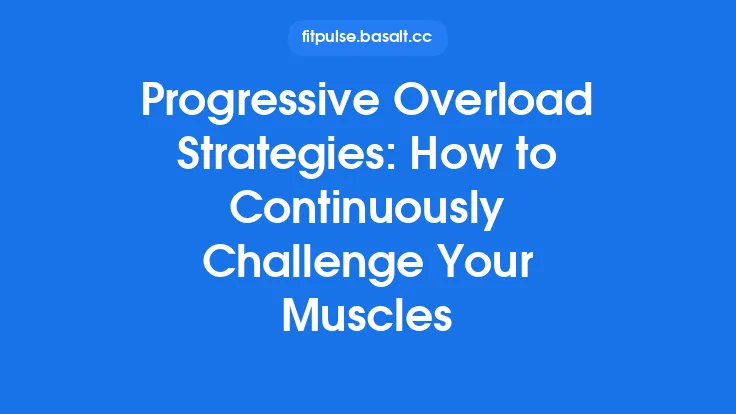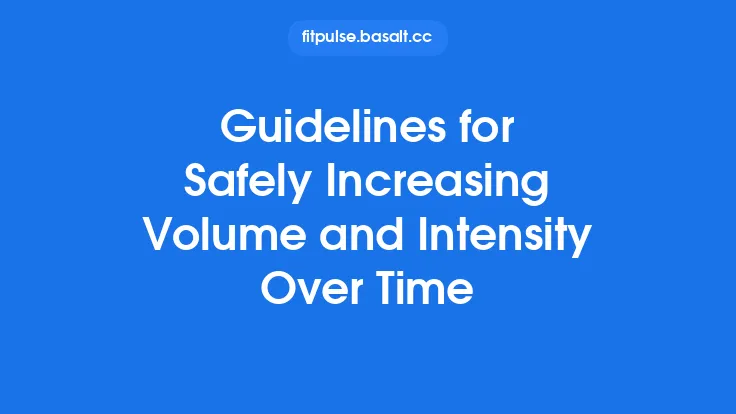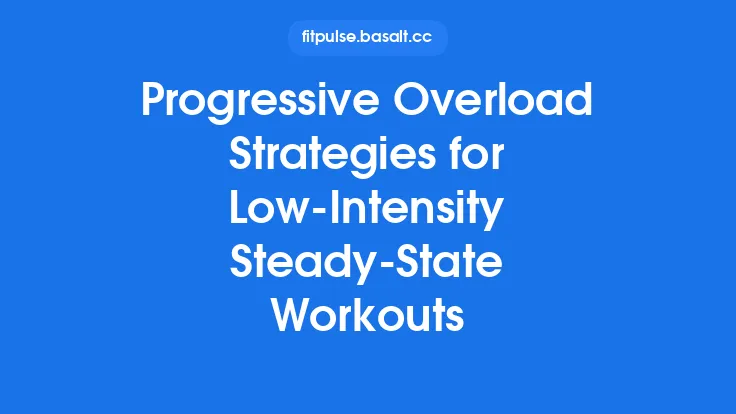High‑Intensity Interval Training (HIIT) is celebrated for its ability to deliver rapid cardiovascular and metabolic adaptations in a short amount of time. Yet, like any stimulus, the body will eventually plateau if the workload remains static. Progressive overload—systematically increasing the training demand—ensures that the physiological stress continues to exceed the current level of adaptation, prompting further improvements in aerobic capacity, anaerobic power, and overall conditioning. Below is a comprehensive guide to applying progressive overload safely and effectively within a HIIT framework.
Understanding Progressive Overload in the Context of HIIT
Progressive overload is a cornerstone of exercise science, traditionally discussed in the realm of resistance training. In HIIT, the principle translates to incremental adjustments in the variables that dictate the intensity and volume of each interval session. The goal is not merely to “work harder” but to do so in a measured way that respects the body’s recovery capacity and minimizes injury risk.
Key concepts to grasp:
| Concept | How it Applies to HIIT |
|---|---|
| Specificity | Overload must target the same energy systems (phosphagen, glycolytic, oxidative) that the HIIT protocol is designed to develop. |
| Individualization | Baseline fitness, health status, and training history dictate the magnitude and rate of progression. |
| Reversibility | Gains are lost when the stimulus is removed; consistent, progressive stimulus is required to maintain adaptations. |
| Adaptation Lag | Physiological improvements often lag behind the training stimulus; a conservative progression schedule helps avoid premature overreaching. |
Key Variables to Manipulate for Overload
Unlike steady‑state cardio, HIIT offers multiple levers that can be tweaked independently or in combination. Understanding each variable’s impact on physiological stress is essential for crafting a balanced progression plan.
- Work Interval Duration (W)
- Effect: Extending the work phase increases time under high metabolic stress, challenging both aerobic and anaerobic pathways.
- Typical Range: 15 s – 90 s for most HIIT protocols. Incremental increases of 5–10 s are common early in a progression.
- Rest Interval Duration (R)
- Effect: Shortening recovery reduces phosphocreatine resynthesis and lactate clearance, raising the overall intensity.
- Progression Strategy: Reduce rest by 5–10 % per micro‑cycle, or replace fixed rest with active recovery at a low intensity.
- Number of Repetitions (Sets)
- Effect: Adding more intervals raises total work volume, increasing cardiovascular load and caloric expenditure.
- Guideline: Add 1–2 intervals per session once the current set count feels comfortably achievable.
- Intensity of the Work Phase
- Metrics: % of maximal heart rate (HRmax), % of VO₂max, power output (watts), or speed (km/h, mph).
- Progression: Increase by 2–5 % of the chosen metric, or introduce a modest external load (e.g., weighted vest, resistance bands) while maintaining movement quality.
- Frequency of HIIT Sessions per Week
- Effect: More frequent high‑intensity stimuli accelerate adaptation but also increase cumulative fatigue.
- Safe Increment: Add an extra session only after a minimum of 2–3 weeks of stable performance and when recovery markers (resting HR, sleep quality) remain favorable.
- Complexity of Movement Patterns
- Effect: Incorporating multi‑joint, plyometric, or sport‑specific drills raises neuromuscular demand.
- Progression: Transition from basic locomotor intervals (e.g., sprint) to more technical variations (e.g., sprint with lateral shuffles) once technique is solid.
Designing a Safe Progression Plan
A well‑structured progression plan balances the desire for rapid gains with the necessity of recovery. Below is a step‑by‑step framework that can be adapted to any fitness level.
1. Baseline Assessment
- Performance Test: Choose a single‑interval benchmark (e.g., 30‑second all‑out sprint on a treadmill or bike) and record peak power, HRmax, and perceived exertion (RPE).
- Recovery Metrics: Capture resting heart rate, HRV (if available), and subjective fatigue scores for three consecutive mornings.
2. Establish the Initial Protocol
- Example Starting Point: 6 × 30 s work / 60 s rest at 85 % HRmax, 2 sessions per week.
- Rationale: Provides a moderate stimulus while leaving ample room for progression in all variables.
3. Choose a Primary Overload Variable
- Rule of Thumb: Alter only one variable per micro‑cycle (usually 1–2 weeks) to isolate its effect.
- Typical Sequence: Work duration → Rest reduction → Additional repetitions → Intensity increase.
4. Define Progression Increments
| Variable | Increment Size | Frequency of Change |
|---|---|---|
| Work interval | +5 s (up to 90 s) | Every 2 weeks |
| Rest interval | –5 s (down to 30 s) | Every 2 weeks |
| Repetitions | +1 set | Every 3 weeks |
| Intensity | +2–3 % HRmax or +5 W | Every 2–3 weeks |
| Frequency | +1 session/week | After 4–6 weeks of stable load |
5. Incorporate Deload Weeks
- Purpose: Allow super‑compensation and reduce injury risk.
- Implementation: Every 4th–5th week, reduce total volume by 30–40 % (e.g., cut two intervals or lower intensity by 10 %). Maintain the same session frequency to preserve habit.
6. Monitor and Adjust
- Objective Data: Heart rate curves, power output, and interval completion times.
- Subjective Data: RPE, muscle soreness, sleep quality, motivation.
- Decision Rule: If any metric indicates excessive strain (e.g., HRmax > 95 % for multiple intervals, RPE > 9, or persistent fatigue), pause progression and repeat the current micro‑cycle or introduce a deload.
Monitoring and Adjusting Intensity
Accurate monitoring is the linchpin of safe overload. Below are practical tools and protocols that can be employed with minimal equipment.
Heart Rate–Based Monitoring
- Zones: Use a 5‑zone model where Zone 4 (80–90 % HRmax) is typical for HIIT work phases. Progression can be quantified by moving the target zone upward.
- Recovery Heart Rate (RHR): Measure HR at the end of each rest interval. A slower decline suggests insufficient recovery.
Power Output (Cycling or Rowing)
- Peak Power: Track the highest wattage achieved in each work interval.
- Average Power: Provides a more stable metric when interval length exceeds 30 s.
Rate of Perceived Exertion (RPE)
- Scale: 0–10 Borg CR10 scale.
- Application: Record RPE at the end of each interval; a consistent rise of >1 point across sessions signals the need for a load adjustment.
Lactate Testing (Optional)
- When to Use: For athletes seeking precise metabolic thresholds.
- Interpretation: A stable or decreasing post‑interval lactate concentration despite higher work intensity indicates successful adaptation.
Recovery Questionnaires
- Tools: Daily Wellness Questionnaire (sleep, mood, muscle soreness) or the Profile of Mood States (POMS).
- Frequency: At least three times per week to capture trends.
Common Pitfalls and How to Avoid Them
| Pitfall | Why It Happens | Prevention Strategy |
|---|---|---|
| Increasing Multiple Variables Simultaneously | Desire for rapid gains. | Stick to a single primary variable per micro‑cycle; use a progression log. |
| Neglecting Recovery Metrics | Overreliance on performance numbers. | Incorporate daily HRV or RHR checks; schedule mandatory deload weeks. |
| Using Fixed Percentages Without Re‑Testing | Assuming HRmax or VO₂max remain static. | Re‑assess maximal effort every 6–8 weeks to update intensity zones. |
| Excessive Session Frequency | Belief that “more is better.” | Limit HIIT to 2–3 sessions per week unless the athlete has a proven high recovery capacity. |
| Ignoring Technique When Adding Load | Adding weight or speed too quickly. | Prioritize movement quality; perform a brief technical check before each interval. |
| Progressing Beyond the Aerobic Threshold | Misinterpreting “hard” as “hard enough.” | Keep work intervals within the targeted metabolic zone (e.g., 80–95 % HRmax) and avoid sustained supra‑max efforts that shift the stimulus to pure anaerobic training. |
Integrating Progressive Overload with Overall Training
While the focus here is on HIIT, most athletes also engage in strength, mobility, and low‑intensity endurance work. A harmonious program respects the cumulative load across modalities.
- Concurrent Training Considerations
- Schedule strength sessions on non‑HIIT days or separate them by at least 6 hours to minimize interference.
- Use low‑intensity steady‑state (LISS) cardio as active recovery on off‑days, not as additional high‑intensity stimulus.
- Periodization at the Macro Level
- Treat the progressive overload plan as a micro‑cycle (2–4 weeks) within a larger mesocycle (8–12 weeks) that may include phases of strength emphasis, hypertrophy, or skill work.
- Ensure that the final weeks of a mesocycle incorporate a taper (reduced volume/intensity) to consolidate gains.
- Nutrition and Sleep
- Adequate protein (1.6–2.2 g·kg⁻¹) supports recovery from high‑intensity bouts.
- Aim for 7–9 hours of quality sleep; consider short naps on heavy HIIT weeks.
Sample 8‑Week Progressive Overload Blueprint
> Assumptions: Athlete is healthy, has completed a baseline HIIT test, and can sustain 85 % HRmax for 30 s intervals.
| Week | Sessions/Week | Work Interval | Rest Interval | Reps | Target HR% | Additional Load | Notes |
|---|---|---|---|---|---|---|---|
| 1‑2 | 2 | 30 s | 60 s | 6 | 85 % | – | Baseline; record HR curves and RPE. |
| 3‑4 | 2 | 35 s | 55 s | 6 | 85 % | – | +5 s work, –5 s rest (single variable). |
| 5‑6 | 2 | 35 s | 55 s | 7 | 85 % | – | Add 1 rep (volume increase). |
| 7‑8 | 2 | 35 s | 55 s | 7 | 88 % | – | Increase intensity by 3 % HRmax. |
| 9‑10 | 2 | 40 s | 50 s | 7 | 88 % | – | +5 s work, –5 s rest. |
| 11‑12 | 2 | 40 s | 50 s | 8 | 88 % | – | Add 1 rep. |
| 13‑14 | 2 | 40 s | 50 s | 8 | 90 % | +5 W (bike) or weighted vest 2 kg | Intensity bump. |
| 15‑16 | 2 | 45 s | 45 s | 8 | 90 % | – | Final overload before deload. |
| 17 (Deload) | 1 | 30 s | 60 s | 4 | 80 % | – | 40 % volume reduction, lower HR zone. |
Key Takeaways from the Blueprint
- Linear progression is evident, but each step respects a 2‑week adaptation window.
- Deload is built in after a 4‑week high‑load block, allowing super‑compensation.
- Intensity spikes are modest (2–3 % HRmax or 5 W) to keep the stimulus within a safe physiological window.
- Volume changes (work duration, reps) are balanced with rest adjustments to avoid excessive cumulative fatigue.
Final Thoughts
Progressive overload is not a one‑size‑fits‑all prescription; it is a systematic, data‑driven approach that respects the unique demands of high‑intensity interval training. By isolating the variables that drive intensity—work duration, rest length, repetitions, effort level, and session frequency—and adjusting them in measured increments, athletes can continue to push their cardiovascular and metabolic limits without courting injury or chronic fatigue.
Remember that the hallmark of a successful overload strategy is feedback. Objective metrics (heart rate, power, lactate) and subjective signals (RPE, sleep, mood) must be reviewed regularly. When the data indicate that the body is coping well, the next incremental step can be introduced. When signs of excessive strain appear, a deload or a return to the previous load is the prudent choice.
With a disciplined progression plan, vigilant monitoring, and a balanced overall training program, HIIT practitioners can enjoy sustained improvements in speed, endurance, and metabolic health—turning the “high‑intensity” label into a long‑term, high‑performance lifestyle.





